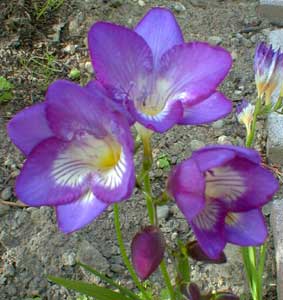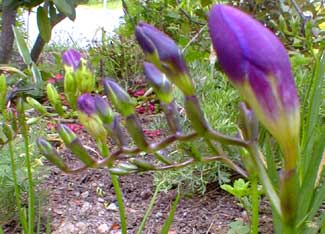
Blue Freesia
Freesias are tender South African natives that do not always establish well, as the corms do not like to freeze in winter. When to plant the corms is very zone-dependent. On Puget Sound (zone 8) we put them in the ground mid February or early March; in colder zones they cannot be put out until April, whereas in the worm south, they should be planted out in autumn.
Their bloom time is not keyed to seasons but occurs six to eight weeks after corms are planted. They make good cut flowers bringing a lovely scent into the house.
They're for certain hardy only in zone 9 or 10, but worth trying in our cooler area especially if it doesn't matter that they may only be around for one year. Finding the sunniest spot will help them perennialize, but if winters ever do drop to twenty degrees F., it's all over; that would be sufficient to do them in.
Even if they do perennialize, they may slowly revert to "ordinary" yellow no matter what color of cultivar one selects. Disappointments can be avoided by regarding them as annuals, & if they last longer than a year, that's just an unexpected bonus.
 Hybrid freesia come in many colors: white, yellow, red, purple, lavender, & many others, including bicolors. We planted two-dozen corms sold as "Blue" freesia. However, despite that the ones we planted were sold as "Blue," & were in a fancy package with deep blue blossoms depicted, they're definitely purple, with white hearts. Some have more white than others; one is violet rather than purple; & another in the group is a very faded lilac, so overall not much uniformity f or a cluster of bulbs bought together.
Hybrid freesia come in many colors: white, yellow, red, purple, lavender, & many others, including bicolors. We planted two-dozen corms sold as "Blue" freesia. However, despite that the ones we planted were sold as "Blue," & were in a fancy package with deep blue blossoms depicted, they're definitely purple, with white hearts. Some have more white than others; one is violet rather than purple; & another in the group is a very faded lilac, so overall not much uniformity f or a cluster of bulbs bought together.They have served us as a bright but transient fill-in while waiting for slow-spreading perennials to take over the spot. For 2004, they have to themselves a little expanse of ground on a well-draining low-maintenance garden's ledge in front of a native Twinberry.
The bloom somewhat resembles crocosmia, especially at the stage of producing the sweeping arc of buds, but upside down. Whereas crocosmia buds & flowers line up on the underside of the arching stem, the buds & funnel-shaped flowers of freesia line up over t he top of each arching stem.
These fragrant members of the Iris family can stand crowding, &am should be planted a scant two inches deep & two inches apart, in a sunny location. They produce fans of sword-shaped leaves similar to glads or irises, a foot or a foot &am pa half tall at most, over which rise those showy stems of trumpet-flowers. They flower in summer the first year, but if any of the corms make it through winters to perennialize, they will quite possibly bloom in spring for future years.
One trick in our zone is to plant the bulbs serially, at week intervals, starting when frosts are less likely, then weekly until the start of April. Because they bloom six to eight weeks after being planted, the staggered planting insures freesias will be blooming in the garden for a longer time.